Conformally Invariant Variational Problems. - SAM
Conformally Invariant Variational Problems. - SAM
Conformally Invariant Variational Problems. - SAM
You also want an ePaper? Increase the reach of your titles
YUMPU automatically turns print PDFs into web optimized ePapers that Google loves.
We note that Γ i (∇u,∇u) := ∑ m<br />
k,l=1 Γi kl ∇uk·∇u l , so that the<br />
harmonic map equation can be recast as<br />
∆u+Γ(∇u,∇u) = 0 .<br />
(VI.6)<br />
This equation raises several analytical questions:<br />
(i) Weak limits : Let u n be a sequence of solutions of (VI.6)<br />
with uniformly bounded energy E g . Can one extract a subsequence<br />
converging weakly in W 1,2 to a harmonic map ?<br />
(ii) Palais-Smale sequences : Let u n be a sequence of solutions<br />
of (VI.6) in W 1,2 (D 2 ,R m ) with uniformly bounded<br />
energy E g , and such that<br />
∆u n +Γ(∇u n ,∇u n ) = δ n → 0 strongly in H −1 .<br />
Can one extract a subsequence converging weakly in W 1,2<br />
to a harmonic map ?<br />
(iii) Regularity of weak solutions : Let u be a map in<br />
W 1,2 (D 2 ,R m ) which satisfies (VI.4) distributionally. How<br />
regular is u ? Continuous, smooth, analytic, etc...<br />
The answer to (iii) is strongly tied to that of (i) and (ii).<br />
We shall thus restrict our attention in these notes on regularity<br />
matters.<br />
Prior to bringing into light further examples of conformally<br />
invariant Lagrangians, we feel worthwhile to investigate deeper<br />
the difficulties associated with the study of the regularity of<br />
harmonic maps in two dimensions.<br />
The harmonic map equation (VI.6) belongs to the class of<br />
elliptic systems with quadratic growth, also known as natural<br />
growth, of the form<br />
∆u = f(u,∇u) ,<br />
(VI.7)<br />
45
















